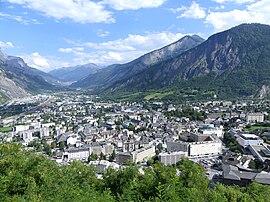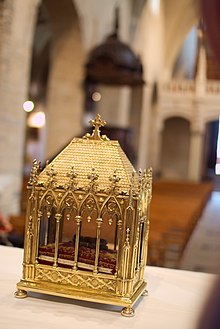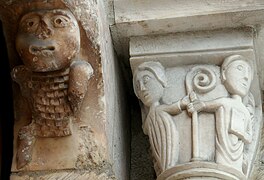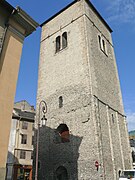
Albertville is a subprefecture of the Savoie department in the Auvergne-Rhône-Alpes region in Southeastern France. It is best known for hosting the 1992 Winter Olympics and Paralympics. In 2018, the commune had a population of 19,214; its urban area had 39,780 inhabitants.
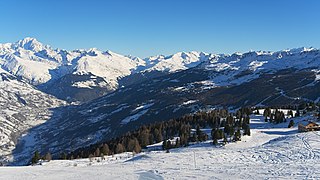
Savoie is a department in the Auvergne-Rhône-Alpes region, Southeastern France. Located in the French Alps, its prefecture is Chambéry. In 2019, Savoie had a population of 436,434.

Aix-les-Bains, known locally and simply as Aix, is a commune in the southeastern French department of Savoie.

Annecy is the prefecture and largest city of the Haute-Savoie department in the Auvergne-Rhône-Alpes region of Southeastern France. It lies on the northern tip of Lake Annecy, 35 kilometres (22 mi) south of Geneva, Switzerland.
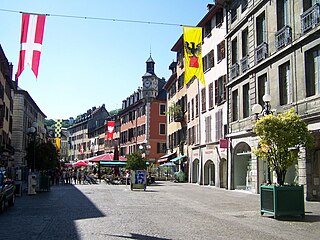
Chambéry is the prefecture and largest city of the Savoie department in the Auvergne-Rhône-Alpes region of southeastern France. The population of the commune of Chambéry was 59,172 as of 2020, while the population of the Chambéry metropolitan area was 255,790. The city is located at the foot of the French Alps between Bauges and Chartreuse mountains, making Chambéry an important railway and highway crossroads.

Moûtiers, historically also called Tarentaise, is a commune in the Savoie department in the Auvergne-Rhône-Alpes region in Southeastern France.
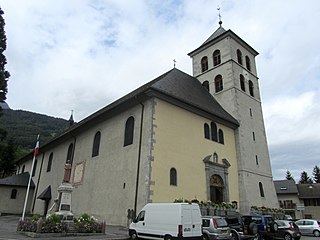
Sallanches is a commune in the Haute-Savoie department of the Auvergne-Rhône-Alpes region of France. Located close to the Mont Blanc massif, many visitors pass through the town en route to well-known alpine resorts such as Chamonix, Megève and Saint-Gervais-les-Bains. In 2018, the commune had a population of 16,508, and its urban area had 46,128 inhabitants.

The arrondissement of Saint-Jean-de-Maurienne is an arrondissement of France in the Savoie department in the Auvergne-Rhône-Alpes region. It has 53 communes. Its population is 43,091 (2016), and its area is 1,976.0 km2 (762.9 sq mi). The area corresponds to the former province of Maurienne.
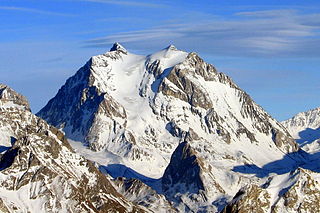
Maurienne is one of the provinces of Savoy, corresponding to the arrondissement of Saint-Jean-de-Maurienne in France. It is also the original name of the capital of the province, now Saint-Jean-de-Maurienne.

Modane is a commune in the Savoie department in the Auvergne-Rhône-Alpes region in southeastern France.

Aiton is a commune in the Savoie department in the Auvergne-Rhône-Alpes region in south-eastern France.

The French Roman Catholic diocese of Saint-Jean-de-Maurienne has since 1966 been effectively suppressed, formally united with the archdiocese of Chambéry. While it has not been suppressed, and is supposed to be on a par with Chambéry and the diocese of Tarentaise, it no longer has a separate bishop or existence.

Bessans is a commune in the Savoie department in the Auvergne-Rhône-Alpes region in south-eastern France. It is located in the valley of Maurienne and crossed by the Arc river. Nestled in the center of a former glacial through, it is renowned for its large Nordic skiing domain in the winter and for its trekking and mountain climbing opportunities in the Summer. Surrounded by lush fauna and flora, the village is characterised by its rich heritage, where wall paintings, Baroque chapels, engraved stones and artisan sculptors are inextricably linked. The legend of the Devil of Bessans admirably describes the originality of this traditional culture that is still very much alive today.

The Culoz–Modane railway is a 135 kilometres long railway running from Culoz, near Chambéry, through Saint-Jean-de-Maurienne to Modane in France. Together with the Italian Turin–Modane railway it is often called "Fréjus Railway" or "Mont Cenis Railway".

The Fortified Section of Savoy(Secteur fortifié de la Savoie) was the French military organization that in 1940 controlled the section of the Alpine Line portion of the Maginot Line facing Italy in the Savoy region. The sector constituted part of the Alpine Line portion of the Maginot Line, between the Defensive Sector of the Rhône to the north, and the Fortified Sector of the Dauphiné to the south. The works combined a number of pre-1914 fortifications with Maginot-style ouvrages, with many forward-positioned cavern-style frontier stations or avant-postes that proved effective in holding invading forces near the order.

The Château de Saint-Michel-de-Maurienne is a 13th-century castle in the commune of Saint-Michel-de-Maurienne Savoie département of France.
The history of Savoy presents a synthesis of the various periods, from prehistory to the present day, of the geographical and historical entity known as Savoy, a territory whose definition has varied over the course of historical periods, until it was defined by the two French departments of Savoie and Haute-Savoie.

The Mont-Cenis Lake is a lake located in the Mont-Cenis massif at an altitude of 1,974 meters in the municipality of Val-Cenis in France. It is situated at the top of the Cenise valley, on the Italian side of the Mont-Cenis pass, the most frequented passage on the Lyon-Turin-Milan axis during the Middle Ages between Western Europe and the Italian peninsula. This was while the Montgenèvre pass required an initial crossing, followed by the Lautaret pass, and the Petit-Saint-Bernard pass was 107 meters higher.

The Arves massif are a massif in the French Alps located in the departments of Savoie, Isère and Hautes-Alpes. Oisans covers part of the massif.

The Savoie region, which encompasses the French departments of Savoie and Haute-Savoie, has a thriving tourism industry. The Savoie Mont Blanc brand represents the region in this sector.
